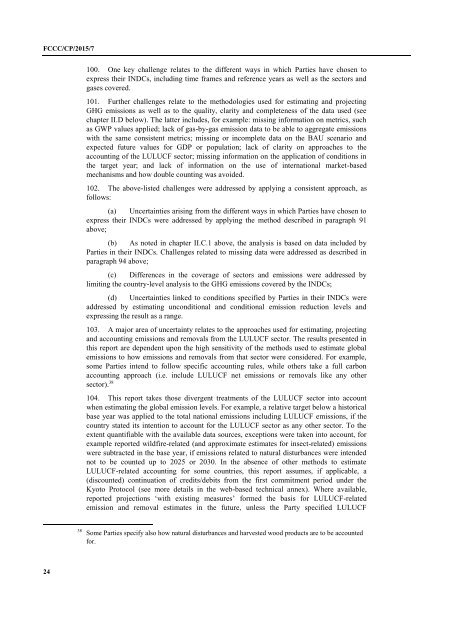FCCC/CP/2015/7
1PYuHQM
1PYuHQM
You also want an ePaper? Increase the reach of your titles
YUMPU automatically turns print PDFs into web optimized ePapers that Google loves.
<strong>FCCC</strong>/<strong>CP</strong>/<strong>2015</strong>/7<br />
100. One key challenge relates to the different ways in which Parties have chosen to<br />
express their INDCs, including time frames and reference years as well as the sectors and<br />
gases covered.<br />
101. Further challenges relate to the methodologies used for estimating and projecting<br />
GHG emissions as well as to the quality, clarity and completeness of the data used (see<br />
chapter II.D below). The latter includes, for example: missing information on metrics, such<br />
as GWP values applied; lack of gas-by-gas emission data to be able to aggregate emissions<br />
with the same consistent metrics; missing or incomplete data on the BAU scenario and<br />
expected future values for GDP or population; lack of clarity on approaches to the<br />
accounting of the LULUCF sector; missing information on the application of conditions in<br />
the target year; and lack of information on the use of international market-based<br />
mechanisms and how double counting was avoided.<br />
102. The above-listed challenges were addressed by applying a consistent approach, as<br />
follows:<br />
(a) Uncertainties arising from the different ways in which Parties have chosen to<br />
express their INDCs were addressed by applying the method described in paragraph 91<br />
above;<br />
(b) As noted in chapter II.C.1 above, the analysis is based on data included by<br />
Parties in their INDCs. Challenges related to missing data were addressed as described in<br />
paragraph 94 above;<br />
(c) Differences in the coverage of sectors and emissions were addressed by<br />
limiting the country-level analysis to the GHG emissions covered by the INDCs;<br />
(d) Uncertainties linked to conditions specified by Parties in their INDCs were<br />
addressed by estimating unconditional and conditional emission reduction levels and<br />
expressing the result as a range.<br />
103. A major area of uncertainty relates to the approaches used for estimating, projecting<br />
and accounting emissions and removals from the LULUCF sector. The results presented in<br />
this report are dependent upon the high sensitivity of the methods used to estimate global<br />
emissions to how emissions and removals from that sector were considered. For example,<br />
some Parties intend to follow specific accounting rules, while others take a full carbon<br />
accounting approach (i.e. include LULUCF net emissions or removals like any other<br />
sector). 38<br />
104. This report takes those divergent treatments of the LULUCF sector into account<br />
when estimating the global emission levels. For example, a relative target below a historical<br />
base year was applied to the total national emissions including LULUCF emissions, if the<br />
country stated its intention to account for the LULUCF sector as any other sector. To the<br />
extent quantifiable with the available data sources, exceptions were taken into account, for<br />
example reported wildfire-related (and approximate estimates for insect-related) emissions<br />
were subtracted in the base year, if emissions related to natural disturbances were intended<br />
not to be counted up to 2025 or 2030. In the absence of other methods to estimate<br />
LULUCF-related accounting for some countries, this report assumes, if applicable, a<br />
(discounted) continuation of credits/debits from the first commitment period under the<br />
Kyoto Protocol (see more details in the web-based technical annex). Where available,<br />
reported projections ‘with existing measures’ formed the basis for LULUCF-related<br />
emission and removal estimates in the future, unless the Party specified LULUCF<br />
38 Some Parties specify also how natural disturbances and harvested wood products are to be accounted<br />
for.<br />
24


